1997 PONTIAC GRAND AM engine
[x] Cancel search: enginePage 82 of 371
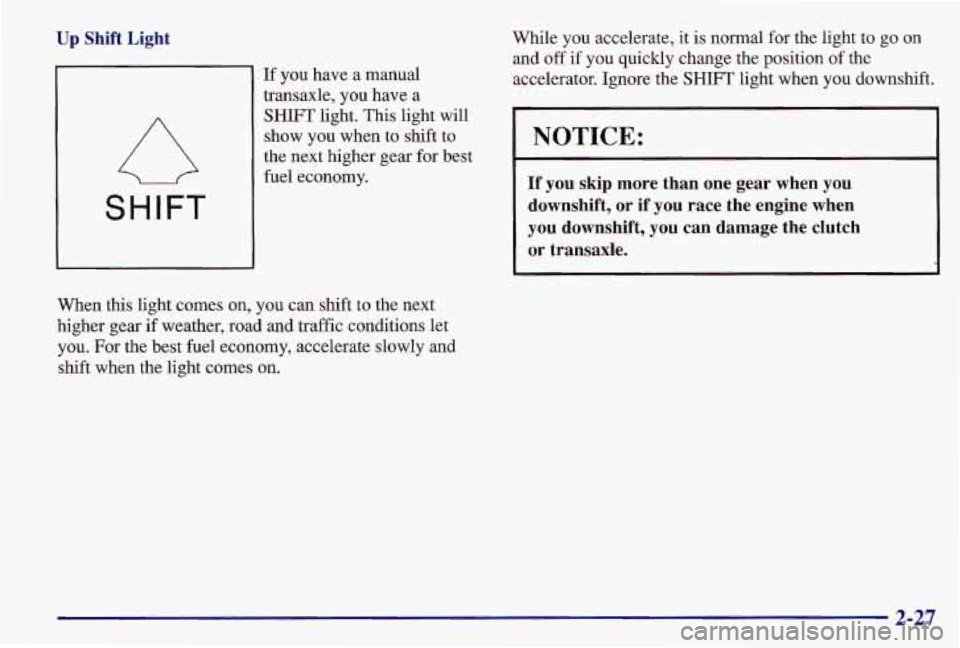
Up Shift Light
SHIFT
If you have a manual
transaxle, you have
a
SHIFT light. This light will
show you when to shift to
the next higher gear for best
fuel economy.
When this light comes on, you can shift
to the next
higher gear if weather, road and traffic conditions let
you. For the best fuel economy, accelerate slowly and
shift when the light comes on. While
you accelerate, it is normal for the light to
go on
and off
if you quickly change the position of the
accelerator. Ignore the
SHIFT light when you downshift.
IOTICE:
If you skip more than one gear when you
downshift, or if you race the engine when
you downshift, you can damage the clutch
or transaxle.
2-27
Page 84 of 371
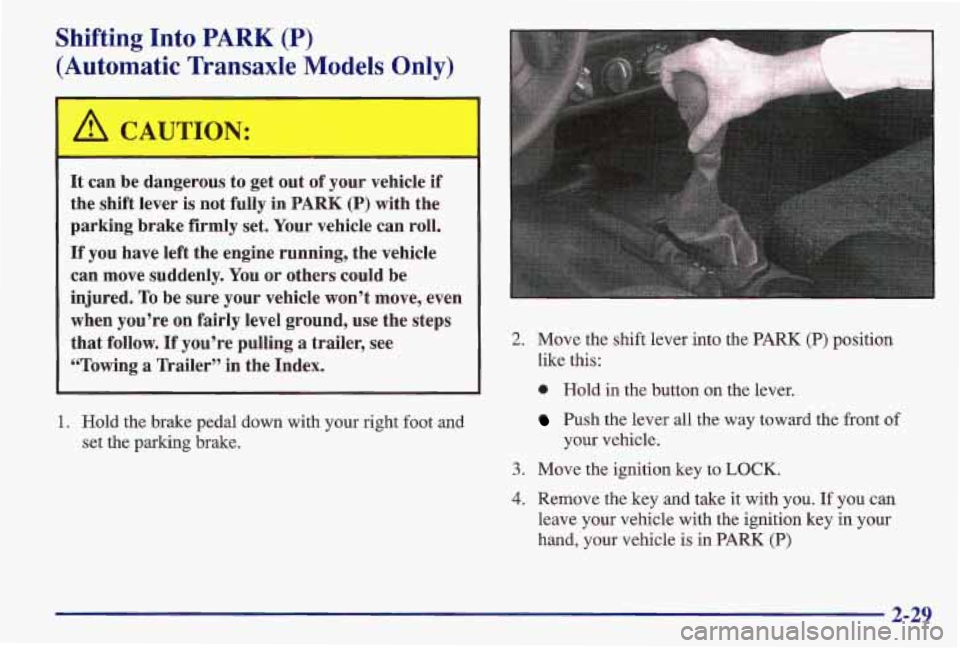
A CAUTION:
-
It can be dangerous to get out of your vehicle if
the shift lever is not fully in
PARK (P) with the
parking brake firmly set. Your vehicle can roll.
If you have left the engine running, the vehicle
can move suddenly.
You or others could be
injured. To be sure your vehicle won’t move, even
when you’re on fairly level ground, use the steps
that follow.
If you’re pulling a trailer, see
“Towing
a Trailer” in the Index.
1. Hold the brake pedal down with your right foot and set the parking brake.
2. Move the shift lever into the PARK (P) position
like this:
0 Hold in the button on the lever.
Push the lever all the way toward the front of
your vehicle.
3. Move the ignition key to LOCK.
4. Remove the key and take it with you. If you can
leave your vehicle with the ignition key in your
hand, your vehicle is in
PARK (P)
2-29
Page 85 of 371
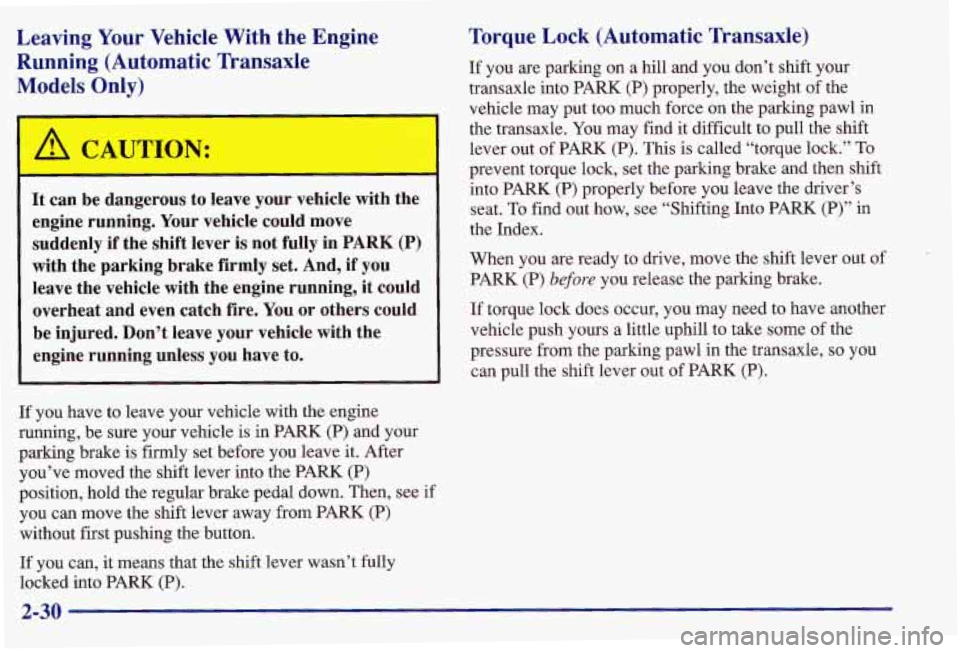
Leaving Your Vehicle With the Engine
Running (Automatic Transaxle
Models Only)
A CAUTION:
I
I
It can be dangerous to leave your vehicle with the
engine running. Your vehicle could move
suddenly if the shift lever is not fully in
PARK (P)
with the parking brake firmly set. And, if you
leave the vehicle with the engine running,
it could
overheat and even catch fire.
You or others could
be injured. Don’t leave your vehicle with the
engine running unless you have to.
If you have to leave your vehicle with the engine
running, be sure your vehicle is in PARK (P) and your
parking brake is firmly set before you leave it. After
you’ve moved the shift lever into the PARK
(P)
position, hold the regular brake pedal down. Then, see if
you can move the shift lever away from PARK (P)
without first pushing the button.
If you can,
it means that the shift lever wasn’t fully
locked into PARK (P).
Torque Lock (Automatic Transaxle)
If you are parking on a hill and you don’t shift your
transaxle into PARK
(P) properly, the weight of the
vehicle may put too much force on the parking pawl in
the transaxle. You may find it difficult to pull the shift
lever out of PARK (P). This is called “torque lock.”
To
prevent torque lock, set the parking brake and then shift
into PARK
(P) properly before you leave the driver’s
seat.
To find out how, see “Shifting Into PARK (P)” in
the Index.
When you
are ready to drive, move the shift lever out of
PARK (P)
before you release the parking brake.
If torque lock does occur, you may need to have another
vehicle push yours a little uphill to take some of the
pressure from the parking pawl in the transaxle, so you
can pull the shift lever out of PARK
(P).
2-30
Page 87 of 371
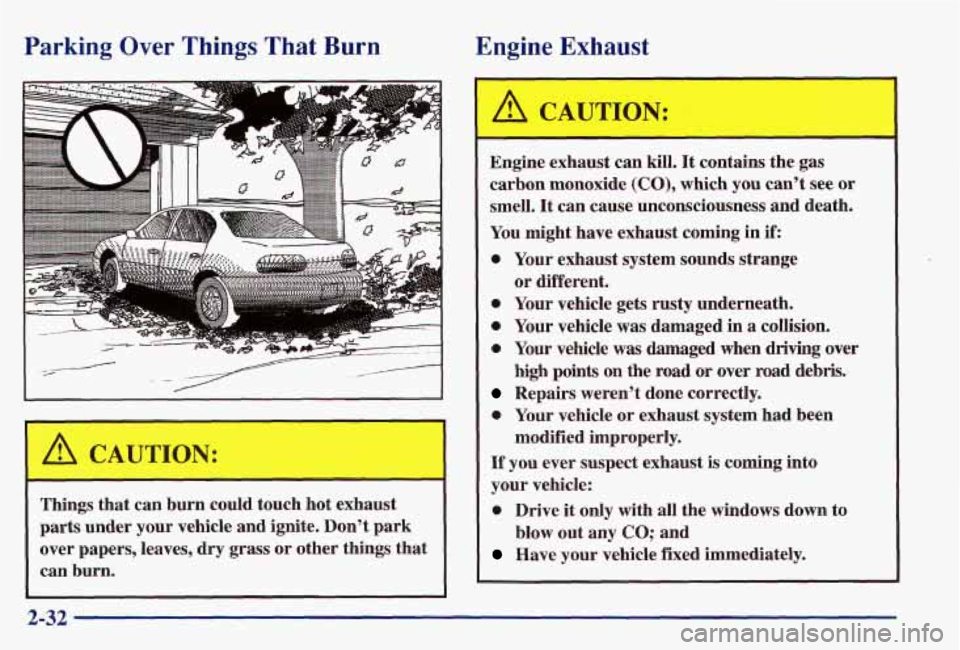
Parking Over Things That Burn Engine
Exhaust
-
Things that can burn could touch hot exhaust
parts under your vehicle and ignite. Don’t park
over papers, leaves, dry grass or other things that
can burn. Engine exhaust can
kill.
It contains the gas
carbon monoxide
(CO), which you can’t see or
smell. It can cause unconsciousness and death.
You might have exhaust coming in if:
0 Your exhaust system sounds strange
0 Your vehicle gets rusty underneath,
0 Your ,vehicle was damaged in a collision.
0 Your vehicle was damaged when driving over
high points on the road or over road debris.
Repairs weren’t done correctly.
0 Your vehicle or exhaust system had been
If you ever suspect exhaust is coming into
your vehicle:
0 Drive it only with all the windows down to
Have your vehicle fixed immediately.
or
different.
modified improperly. blow out any
CO; and
2-32
Page 88 of 371
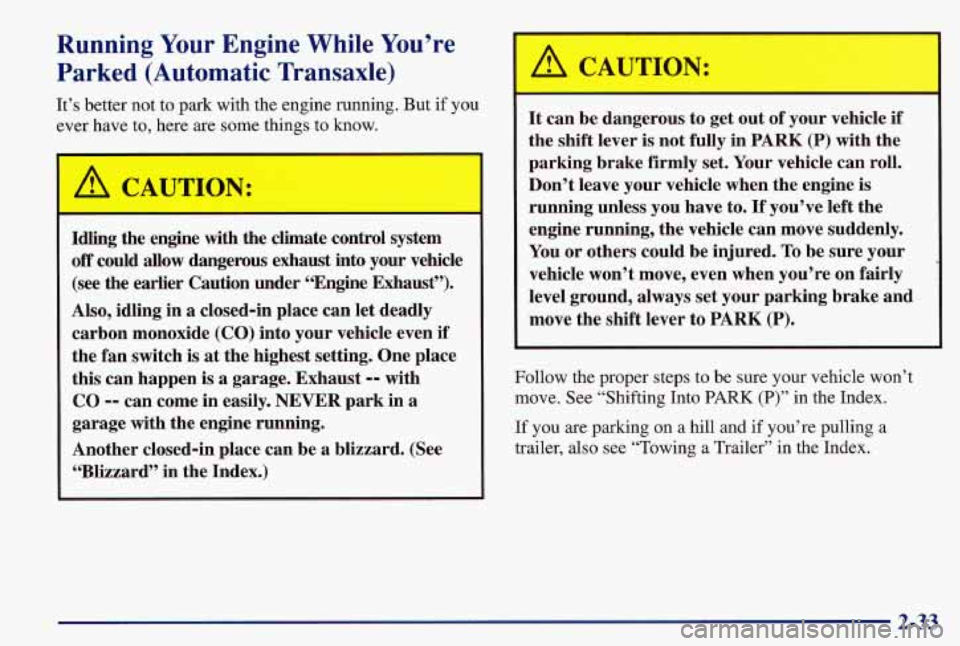
Running Your Engine While You’re
Parked (Automatic Transaxle)
It’s better not to park with the engine running. But if you
:ver have to, here are some things
to know.
h
A CAUTION:
Idling the engine with the climate control system
off could allow dangerous exhaust into your vehicle
(see the earlier Caution under “Engine Exhaust”),
Also, idling in a closed-in place can let deadly
carbon monoxide (CO) into your vehicle even if
the fan switch is at the highest setting. One place
this can happen is
a garage. Exhaust -- with
CO
-- can come in easily. NEVER park in a
garage
with the engine running.
Another closed-in place can be a blizzard, (See
“Blizzard” in the Index.)
I
A CAUTION:
It can be dangerous to get out of your vehicle if
the shift lever is not fully in PARK (P) with the
parking brake firmly set. Your vehicle can roll.
Don’t leave your vehicle when the engine is
running unless you have to.
If you’ve left the
engine running, the vehicle can move suddenly.
You or others could be injured. To be sure your
vehicle won’t move, even when you’re on fairly
level ground, always set your parking brake and
move the shift lever to PARK (P).
Follow the proper steps to be sure your vehicle won’t
move. See “Shifting Into
PARK (P)” in the Index.
If you are parking on a hill and if you’re pulling a
trailer, also see “Towing a Trailer” in the Index.
2-33
Page 99 of 371

Daytime Running Lamps
Daytime Running Lamps (DRL) can make it easier for
others to see the front
of your vehicle during the day.
DRL can be helpful in many different driving
conditions, but they can be especially helpful in the
short periods after dawn and before sunset.
The DRL system will make your high-beam headlamps
come on at a reduced brightness when:
The engine is running,
0 The headlamp switch is in the OFF position,
The light sensor detects daytime light,
0 The parking brake is released and
The shift lever is not in PARK (P) on an
automatic transaxle.
When the DRL system is on, the taillamps, sidemarker,
park lamps
and instrument panel lights will not be
illuminated.
The DRL and the ALC systems will remain off any time
your automatic transaxle vehicle is in PARK (P) and the
parking brake is engaged.
The DRL and the ALC systems will remain
off any time
your manual transaxle vehicle is in NEUTRAL (N) and
the parking brake is engaged.
Automatic Light Control (ALC)
Your vehicle is equipped with an automatic light sensor
on top of the instrument panel under the defroster grill,
so be sure it is not covered which will cause the
nighttime lights to be on continuously.
When it is dark enough outside, your ALC will turn
on
your low-beam headlamps at the normal brightness
along with other lamps such as the taillamps,
sidemarker, park lamps and instrument panel lights.
There is a 20-second delay in the transition between
daytime and nighttime operation
of the DRL and the
ALC systems.
If the light sensor senses a reduction in
lighting that lasts longer than
20 seconds, it will activate
the nighttime lamps. If you are driving through a
parking garage, heavy overcast weather, a tunnel or
fueling your vehicle in a low light area, the ALC will
turn on your low-beam headlamps at a normal
brightness along with the taillamps, sidemarker, park
lamps and the instrument panel lights. The radio lights
will be dimmer.
As with any vehicle, you should turn on the regular
headlamp system when you need
it.
Page 113 of 371

Tachometer
The tachometer shows your
engine speed in revolutions
per minute (rpm).
Warning Lights, Gages and Indicators
This part describes the warning lights and gages that may
be on your vehicle. The pictures will help you locate them.
Warning lights and gages can signal that something is
wrong before it becomes serious enough to cause an
expensive repair or replacement. Paying attention to
your warning lights and gages could also save you or others from injury.
Warning lights come on when there may be or is a
problem with one of your vehicle’s functions.
As you will
see
in the details on the next few pages, some warning
lights come on briefly when you start the engine just to let \
you know they’re working. If you are familiar with this
NOTICE: section, you should not be alarmed when this happens.
Gages can indicate when there may be
or is a problem
Do not run your engine at speeds in the red area,
warning lights work together to let you know when or engine damage may occur.
with one of your vehicle’s functions. Often gages and
there’s a problem with your vehicle. When one
of the warning lights comes on and stays on
when
you are driving, or when one of the gages shows
there may be a problem, check the section that tells you what to
do about it. Please follow this manual’s advice.
Waiting to do repairs can be costly
-- and even
dangerous.
So please get to know your warning lights
and gages. They’re a big help.
Page 114 of 371

Safety Belt Reminder Light
When the key is turned to RUN or START, a chime will
come on for about eight seconds to remind people to
fasten their safety belts, unless the driver’s safety belt is
already buckled,
The safety belt light will also come on and stay
on for about
20 seconds,
then it will flash for about
55 seconds. If the driver’s
belt is already buckled,
neither the chime nor the
light will come on.
Air Bag Readiness Light
There is an air bag readiness light on the instrument
panel, which shows AIR BAG. The system checks the
air bag’s electrical system for malfunctions. The light
tells you
if there is an electrical problem. The system
check includes the air bag sensor, the air bag modules,
the wiring and the crash sensing and diagnostic module.
For more information on the air bag system, see “Air
Bag”
in the Index.
AIR
BAG
This light will come on
when you start your engine,
and it will flash for a few
seconds. Then the light
should go out. This means
the system is ready.
If the air bag readiness light stays on after you start the -
engine or comes on when you are driving, your air bag
system may not work properly. Have your vehicle
serviced right away.
The
air bag readiness light should flash for a few
seconds when you turn the ignition key to RUN.
If the
light doesn’t come on then, have it fixed
so it will be
ready to warn you
if there is a problem.
2-59